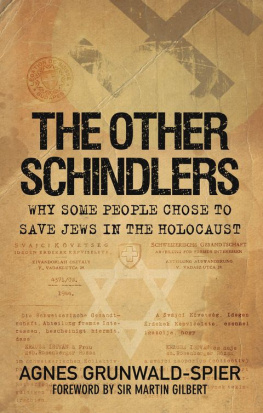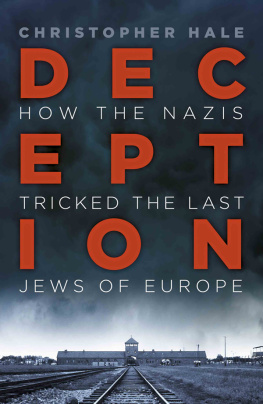KASZTNERS CRIME
Jewish Studies Series
William B. Helmreich, editor
Jewish Studies is an interdisciplinary series devoted to the study of Jewish history, religion, and culture.
Titles in this series include:
Kasztners Crime
Let My People Go
God Laughed
The Jewish Divide Over Israel
Jews and Gentiles
Classical Liberalism and the Jewish Tradition
The Complete Black Book of Russian Jewry
Nine American Jewish Thinkers
The Enduring Community
Saving Children
Strangers in Paradise
Jewish Identity
Toward Modernity
The Court Jew
Understanding American Jewry
KASZTNERS CRIME
PAUL BOGDANOR
First published 2016 by Transaction Publishers
Published 2017 by Routledge
2 Park Square, Milton Park, Abingdon, Oxon OX14 4RN
711 Third Avenue, New York, NY 10017, USA
Routledge is an imprint of the Taylor & Francis Group, an informa business
Copyright 2016 by Taylor & Francis.
All rights reserved. No part of this book may be reprinted or reproduced or utilised in any form or by any electronic, mechanical, or other means, now known or hereafter invented, including photocopying and recording, or in any information storage or retrieval system, without permission in writing from the publishers.
Notice:
Product or corporate names may be trademarks or registered trademarks, and are used only for identification and explanation without intent to infringe.
Library of Congress Catalog Number: 2016026729
Library of Congress Cataloging-in-Publication Data
Names: Bogdanor, Paul, author.
Title: Kasztners crime / Paul Bogdanor.
Tescription: New Brunswick : Transaction Publishers, [2016] | Includes bibliographical references and index.
Identifiers: LCCN 2016026729| ISBN 9781412863407 (hardcover) | ISBN 9781412864435 (pbk.)
Subjects: LCSH: Kasztner, Rezsno Rudolf, 1906-1957. | World War, 1939-1945--Jews--Rescue--Hungary. | Holocaust, Jewish (1939-1945)--Hungary. | Journalists--Hungary--Biography. | Lawyers--Hungary--Biography.
Classification: LCC D804.6 .B64 2016 | DDC 940.53/18092 [B] --dc23
LC record available at https://lccn.loc.gov/2016026729
ISBN 13: 978-1-4128-6340-7 (hbk)
ISBN 13: 978-1-4128-6443-5 (pbk)
I would like to thank the staff at the following archives for their assistance: Central Zionist Archives (Jerusalem), Haganah Archives (Tel Aviv), Jabotinsky Institute (Tel Aviv), Joint Distribution Committee Archives (New York), Labor Party Archive (Beit Berl College, Kfar Saba), National Archive and Records Administration (College Park, MD), Strochlitz Institute for Holocaust Research (Haifa), The National Archives (London), Wiener Library (London), and Yad Vashem (Jerusalem).
I would also like to thank the following individuals: Edward Alexander, Dan Anbar, Zvi Atir, Adam Bogdanor, Judy Bogdanor, Nigel Bowles, Randolph Braham, Noga and Ehud Duchovni, Stefan Fischer, Mark Gardner, Moshe Golan, Michael Hay and Amanda Mackenzie Stuart, Suzanna Harsanyi, Nadav Kaplan, Zsuzsi Kasztner, Ruth Landau, Ruth Linn, Ladislaus Lb, Jacob Lyons, Karla Mller-Tupath, Ayala Nedivi, Ofra Offer, Akiva Orr, Ann Pasternak-Slater, Michael Pinto-Duschinsky, Susan Pollack, Joseph Ragaz, Dave Rich, Alvin Rosenfeld, Ruth Tamir, Zoltn Tibori Szab, Bill Treharne Jones, Rafael Vago, Margaret Verms, Robin Vrba, Gerta Vrbova, Zuza Vrbova, Menahem Weber, and Lily Zamir.
Special thanks to Michael N. Ezra, whose interest in Kasztner spurred me on as I was writing. Michael generously read and commented on every chapter; his invaluable feedback substantially improved the book. Dr. Eli Reichenthal of Ben-Gurion University gave me access to the documents from the Kasztner and Dinur Archives cited in this book, and he made some of the translations from Hebrew and all of the translations from Hungarian.
My final debt is to the highly professional people at Transaction for their hard work in guiding this book to publication: Mary E. Curtis, Lauren Bridges, Aileen Bryant-Allen, Andrew McIntosh, Eileen Ramos, Jeffrey Stetz, and Mindy Waizer.
None of the arguments in this book should be attributed to any of those just named; a few of them totally reject my conclusions. Responsibility for any errors is mine.
This book is about one of the most intense controversies of the Holocaust. It explains how an attempt to save the innocent became an instrument of their murder. It shows how the illusion of rescue was used to camouflage the reality of genocide and then turned into an alibi for war criminalsand how the protests of the survivors have been consigned to oblivion.
By 1944 the majority of Jews in the Nazi sphere of influence were dead. Yet Hungarys Jewish community, though far from unscathed, was largely intact. Moreover, many Hungarian Jews were still oblivious to the fate that had befallen millions of their coreligionists under Hitlers rule. On March 19, 1944, their innocence was suddenly and cruelly shattered when the Nazis occupied Hungary. Accompanying the German armed forces were Adolf Eichmann and his SS staff. Their mission was to organize the deportation of all the Jews in Hungaryover three-quarters of a million men, women, and childrento Auschwitz.
Eichmann had only 150200 SS personnel at his disposal. He also had very little time: the Nazis were losing the war, and it would not be long before the Germans were beaten back by the Red Army. It was no simple matter to murder so many people in such a brief interval. Nevertheless, Eichmann performed his grisly task with extraordinary speed and efficiency: for eight weeks, beginning in mid-May 1944, he was able to load Jews onto the death trains at the rate of up to twelve thousand souls per day.
As they were making the arrangements for this tremendous slaughter, officers of the SS conducted rescue negotiations with representatives of Hungarys Jewish population. One of the aims of these negotiations, from the Nazi standpoint, was to lull the Jewish side into a false sense of security and to abort any effective steps to save Jewish lives. The key Jewish figure in the talks with the SS was Rezs Kasztner, acting head of a small Zionist rescue committee in Budapest. Kasztner had already compiled a record of courageous activism in saving Jews from extermination in Poland and Slovakia. Recognizing his importance, the SS officers granted him special exemptions from their antisemitic measures and treated him as the major spokesman for Hungarys Jews.
In the fateful weeks of the mass deportations to Auschwitz, Kasztner and Eichmann were locked in heated discussions about the possibility of sparing Jewish lives. Ultimately Eichmann agreed to gather a special group of 1,684 Jews, who were first taken hostage and later sent to Switzerland by train. By that point, Eichmann and his local henchmen had rounded up well over four hundred thousand other Jews and sent them to a terrible destination. At the end of the war, the Jewish death toll from the Nazi occupation of Hungary stood at half a million.
During the negotiations, Eichmann presented a rescue plan that was as far-reaching as it was far-fetched. He announced to Kasztners colleague Joel Brand that he was prepared to free a million Jews from Nazi-occupied Europe in exchange for ten thousand trucks and other goods from the West. Brand traveled to Turkey to explain the offerthe so-called Goods for Blood dealto the Zionist movement. The latter duly informed the British and lobbied for their support. But Eichmann, who had promised to postpone the destruction of Hungarys Jews until the end of Brands mission, was already delivering hundreds of thousands to the gas chambers.







